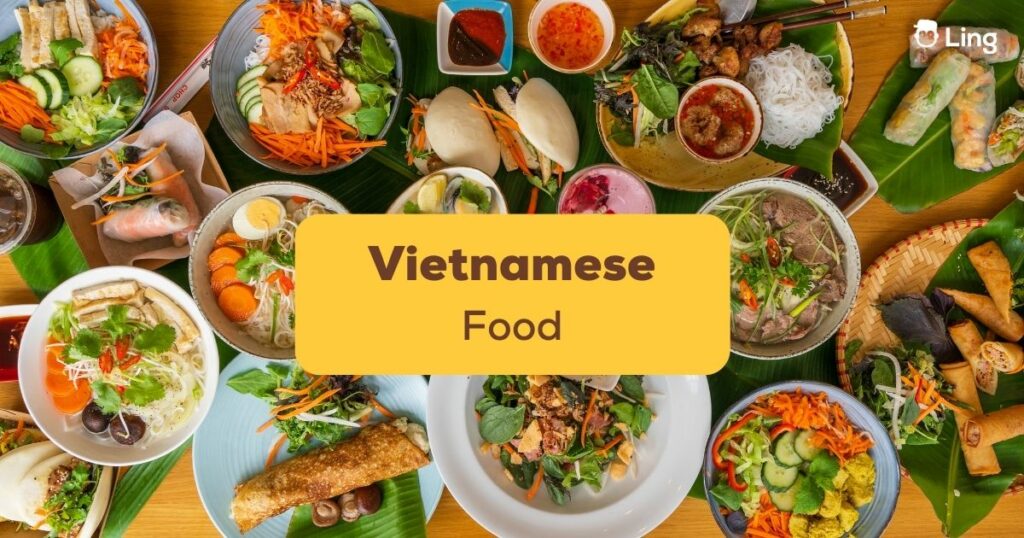Vietnamese food should definitely be on your list if you’re a foodie who loves trying new cuisines. As someone who travels often, I realized that Vietnamese cuisine has become increasingly popular around the world thanks to its distinct bold flavors, fresh ingredients, and variety of dishes. With this quick guide, we’ll take you on a journey through the best of Vietnamese cuisine. We’ll cover everything you need to know to start exploring this delicious cuisine, from its fascinating history to its regional differences. So put on your stretchy trousers and prepare for a delightful adventure into the world of Vietnamese food!
Today, it’s impossible not to come across lines of Vietnamese restaurants and pop-up stores. Part of the reason behind this is that their cuisine is one of the healthiest ones out there. From fresh herbs and spices that add depth and flavors to vegetables, they have everything a health-conscious individual will love. Their cuisine also incorporates a variety of textures, from crispy banh mi bread to chewy rice noodles, making it both satisfying and enjoyable to eat.
Ready to learn more about this mouthwatering topic? Read on below!
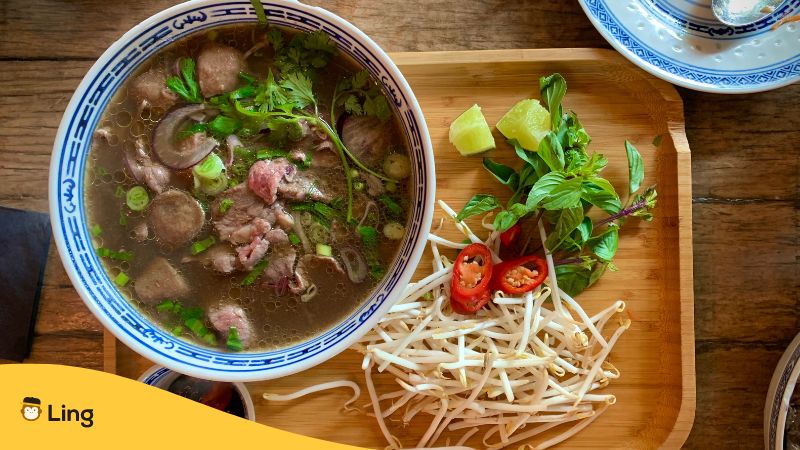
Vietnamese Food
Vietnamese cuisine is rich and varied and has been influenced by various cultures over the centuries. In fact, historical records show that the cuisine has been shaped by its geography and has been influenced by China, Cambodia, and Thailand.
The Chinese were responsible for introducing rice cultivation, which made rice a staple in the Vietnamese diet. With that said, the Vietnamese people took to rice immediately, creating their own versions of cooking sticky rice, creating rice flour, and developing their own rice paper. Additionally, French colonization also significantly impacted Vietnamese cuisine, introducing bread, coffee, and other ingredients.
Most Common Vietnamese Foods
Phở
Phở is a Vietnamese noodle dish or soup, usually made with beef or chicken stock, rice noodles, and various herbs and spices, including basil, coriander, and lime. Slices of beef or chicken, bean sprouts, and chili peppers are often added. Beef or chicken broth is used as the base. Phở is a popular street food in Vietnam. It is enjoyed by people from all backgrounds, from Northern, Southern, and Central Vietnam.
Often eaten for breakfast or lunch, it is considered a comfort food. The exact origin of phở is unclear. However, it is believed to have originated in the northern regions of Vietnam in the early 20th century. Today, phở is enjoyed worldwide and considered one of the most emblematic dishes of Vietnamese food.
How To Order Pho In Vietnamese
| English | Vietnamese |
| One bowl of beef phở, please | Một bát phở bò, xin cảm ơn |
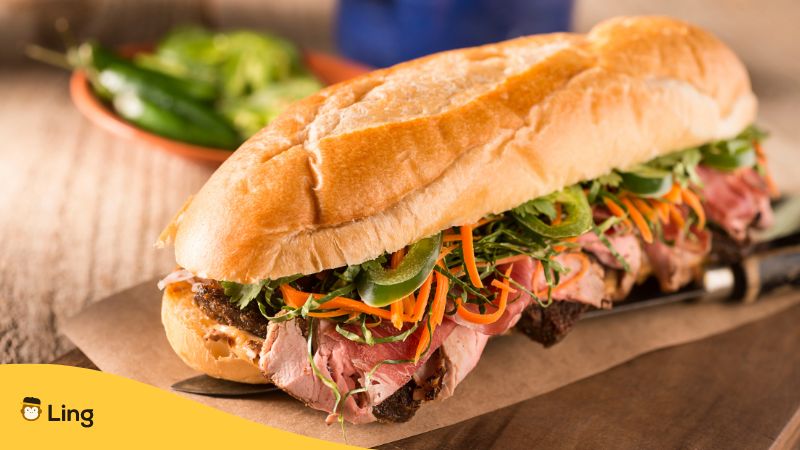
Bánh Mì
The banh mi is a famous Vietnamese sandwich that has gained immense popularity worldwide. Served on a French baguette, this culinary delight consists of various fillings, including meat, vegetables, and sauces. Meat fillings can range from pork belly to grilled chicken. Vegetables can include pickled carrots, spring onions, and coriander.
Sauces, an essential element of this sandwich, are typically a combination of mayonnaise, soy sauce or sauces, and sweet chili sauce or sauces, creating a perfect balance of sweet, savory, and spicy tastes. A must-try dish for anyone who loves good food, banh mi is a perfect example of Vietnamese cuisine’s fusion of flavors, textures, and cultures.
How To Order Bánh Mì In Vietnamese
| English | Vietnamese |
| One Bánh Mì with pâté | Một bánh mì pâté. |
| One Bánh Mì with meatballs | Một bánh mì xíu mại. |
| One Bánh Mì with grilled pork | Một bánh mì thịt nướng. |
| One Bánh Mì with Vietnamese ham | Một bánh mì chả lụa. |
| One Bánh Mì with eggs | Một bánh mì trứng. |
Bún Chả
Bún chả is a Vietnamese dish that is thought to have originated in Hanoi, Vietnam. It is a combination of grilled meat and rice noodles, served with a side dish of dipping sauce and herbs. Typically, the dish is made up of grilled fatty pork (chả) served over a plate of white rice noodles (bún) with a side dish of dipping sauce.
The dipping sauce is typically made with fish sauce, sugar, vinegar, and chili. It is served with herbs such as perilla leaves, lettuce, coriander, and morning glory, with some topping the whole ordeal with crispy fried shallots. The grilled meatballs are often seasoned and caramelized. They are served in a broth alongside noodles, fried tofu, and vegetables.
How To Order Bún Chả In Vietnamese
| English | Vietnamese |
| One serving of Bún chả, please. | Một phần Bún chả, vui lòng |
| Give me a plate of Bún chả. | Cho tôi một đĩa Bún chả |
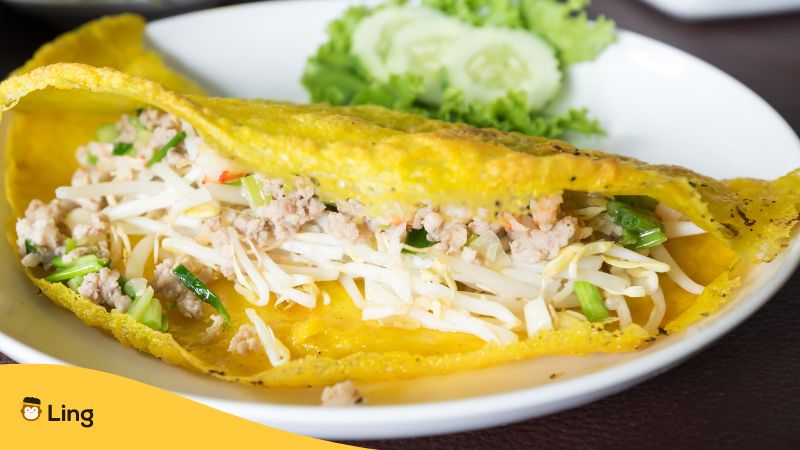
Banh Xeo
Bánh xèo is a traditional Vietnamese dish typically served as a savory crepe filled with various ingredients such as pork, shrimp, bean sprouts, and green onions. The crepe is made from rice flour, turmeric, and coconut milk, giving it a distinct yellow color and a slightly sweet flavor.
Once cooked, the crepe is folded over the filling and served with fresh herbs and lettuce leaves to wrap it in. Banh xeo is often accompanied by a sweet and sour dipping sauce called nước chấm, made from fish sauce, lime juice, sugar, and chili peppers. Bánh xèo is a popular street food in Vietnam and is enjoyed both as a snack and a meal!
How To Order Bánh Xèo In Vietnamese
| English | Vietnamese |
| One plate of Bánh Xèo, please. | Cho tôi một đĩa Bánh Xèo |
Gỏi Cuốn
Gỏi cuốn, also known as Vietnamese spring rolls, is a popular dish in Vietnamese cuisine. The rolls contain various fresh ingredients, such as shrimp, pork, rice vermicelli, lettuce, and herbs, all wrapped in translucent rice paper. The dish is often served cold and is accompanied by a peanut dipping sauce called nước lèo, which is made from peanut butter, hoisin sauce, and other seasonings.
Gỏi cuốn is a healthy and refreshing dish perfect for a light meal or as an appetizer. It is also easy to customize according to your preferences by adding or removing ingredients, such as roasted peanuts, mung bean paste, or pork skin, to truly customize the taste! If you want a taste of Vietnamese cooking beyond noodle soups, this dish is for you.
How To Order Gỏi Cuốn In Vietnamese
| English | Vietnamese |
| One plate of Gỏi Cuốn, please. Thank you. | Cho tôi một đĩa Gỏi Cuốn, xin cám ơn. |
| Please give me some peanut dipping sauce to go with the Gỏi Cuốn. | Cho tôi thêm nước lèo để chấm kèm Gỏi Cuốn. |

Differences In Regional Vietnamese Foods
Vietnamese cuisine is known for its delicate balance between sweet, sour, salty, and spicy flavors and its use of fresh herbs and vegetables. However, there are subtle differences between the cuisine of Northern, Central, and Southern Vietnam. Let’s get to know that in the sections below!
Northern Vietnamese Food
Northern Vietnamese cuisine is known for its simplicity and use of fewer herbs and spices than the other two regions. Dishes are often light and refreshing, focusing on rice and noodle dishes. Some iconic Northern Vietnamese dishes include phở (beef and rice noodle soup), bánh cuốn (steamed rice rolls), and chả cá lã vọng (grilled fish with turmeric and dill). You’ll find Vietnamese restaurants in this area to be a bit more on the mild side.
Central Vietnamese Food
Central Vietnamese cuisine is known for its spiciness and use of bold flavors. The region is home to the ancient city of Hue, once Vietnam’s imperial capital. Hue cuisine is often associated with its royal court cuisine, known for its intricate preparation and presentation. Some signature dishes from Central Vietnam include bún bò Huế (spicy beef noodle soup), nem lụi (lemongrass skewers), and bánh xèo (crispy rice flour pancake).
Southern Vietnamese Food
Southern Vietnamese cuisine is known for its sweetness, the use of coconut milk in many dishes, and the influence of Chinese and Khmer cuisine. In addition, the region is known for its use of herbs and vegetables, and its dishes often feature a variety of textures and flavors. Some iconic Southern Vietnamese dishes include bánh xeo (savory pancake), bún thịt nướng (grilled pork and vermicelli), and hủ tiếu (pork and seafood noodle soup).
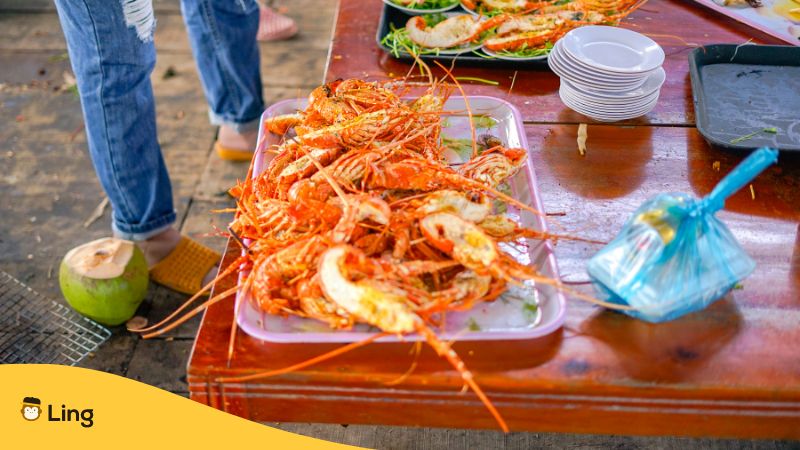
Vietnamese Street Food
Vietnamese street food is a lively and diverse cuisine, encompassing a range of dishes, tastes, and ingredients. From bánh mì (Vietnamese sandwich) to phở (beef noodle soup), street vendors serve a range of bold, complex tastes. Some famous street food dishes are bành xèo (crispy rice flour cakes), gỏi cuốn (spring rolls), and bún chả (grilled pork and vermicelli).
But hey! Did you know that the locals enjoy seafood street food as well? Some popular Vietnamese seafood dishes include cá kho tộ (caramelized fish in a clay pot), hải sản nướng (grilled seafood), chả cá lã vọng (grilled fish with turmeric and dill), and bún riêu cua (crab noodle soup).
Fresh herbs like lemongrass, ginger, and kaffir lime leaves are often used in these dishes, adding depth and complexity to the flavors. Noodle soups use flat rice noodles that absorb flavor very well, giving you an excellent taste of the sea. Whether grilled, fried, or simmered in a flavorful broth, Vietnamese seafood dishes are a delicious way to experience the flavors of Vietnam’s coastal regions.
Eating street food is a great way to experience local culture and cuisine. When in Vietnam, you’ll often find yourself eating on small plastic stools along the sidewalk with everyone else! You’ll surely find delicious street food to tantalize your taste buds in Hanoi, Ho Chi Minh City, or any other city in Vietnam.
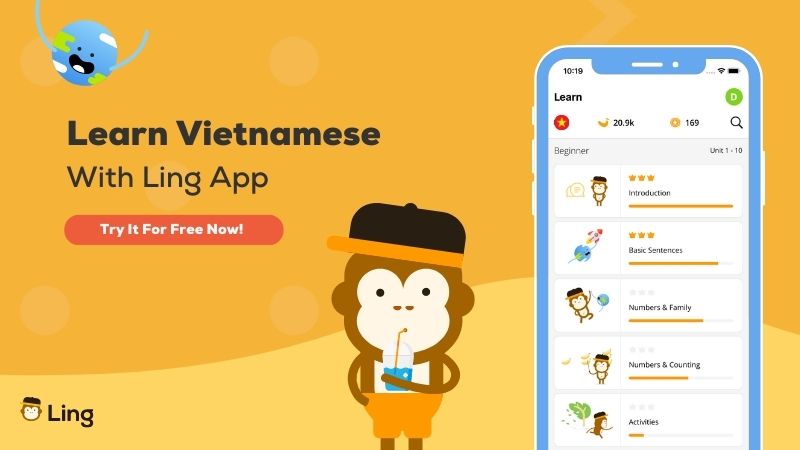
Learn More About Vietnamese Foods With Ling App
Before booking your trip to Ho Chi Minh City to feast on some cold rice noodles and grilled pork chop, consider learning a little more about the Vietnamese language to make your visit truly worth it!
Get all the Vietnamese lessons you need with the Ling app, with lessons in Vietnamese and 60+ other languages that can take your language skills from zero to hero. Each lesson is designed to be easy to follow and memorable, so you can speak like a local in no time. Ready to check it out? Learn Vietnamese today by downloading the Ling app from Android or iPhone today to get started!
